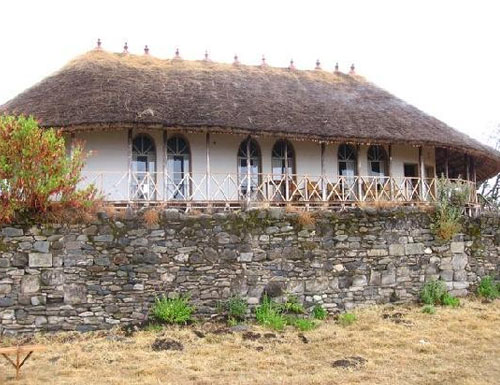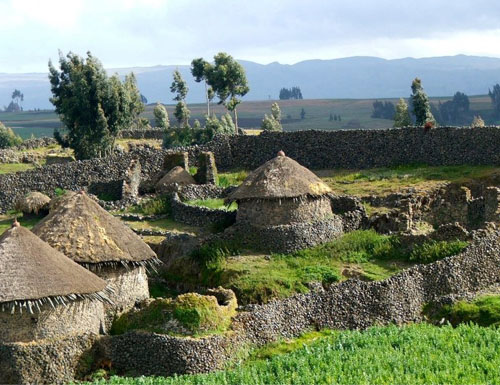Ankober, also known as Gorobela,[1] is a town in central Ethiopia and one of the capitals of the former kingdom of Shewa. Located in the Semien Shewa Zone of the Amhara Region, Ankober is perched on the eastern escarpment of the Ethiopian Highlands 40 kilometers to the east of Debre Birhan, with a latitude and longitude of 9.6077°N 39.736239°ECoordinates: 9.6077°N 39.736239°E, and an approximate elevation of about 2465 meters.
The gravel road between Ankober and Debre Berhan, 42 kilometers in length, was overhauled in May 2009.

Buildings that survive from the Shewa period include the Kidus Mikael church, built by Sahle Selassie. According to Philip Briggs, all that survives of Menelik's palace, which he had built on the site of his father's palace, is "one long stone-and-mortar wall measuring some 1.5m high." Briggs comments that it is "difficult to say why this one wall should have survived virtually intact when the rest of the palace crumbled into virtual oblivion." Ankober is also known as where the endemic Ankober Serin was first observed by ornithologists in 1979.
History
Meridazmach Amha Iyasus, moved the capital of Shewa from Doqaqit to Ankober, and it remained the principal residence of the rulers of Shewa until Negus (later Emperor) Menelik II moved it to Mount Entoto in 1878, although Wossen Seged preferred to live at Qundi during his reign.[4] The name of the town is said to have been taken from an Oromo Queen, Anko, who ruled the town during the reign of Qedami Qal.
The first Europeans to record their visit to Ankober were the Evangelical missionaries Carl Wilhelm Isenberg and Johann Ludwig Krapf in 1839.[6] However, at the time there was a small colony of Greeks, who made their living as craftsmen and tradesmen. In the following years, a steady stream of travellers visited Ankober, including Captain William Cornwallis Harris. Following the death of Meridazmach Sahle Selassie in 1847, the Abichu Oromo rebelled and attacked Ankober; only the firearms Sahle Selassie had collected there saved the capital. The Shewans burned the town in 1856 in reaction to the invasion, and eventual conquest, of Emperor Tewodros II. It was soon rebuilt, and used by Tewodros's appointees Haile Mikael and Seyfe Sahle Selassie as their seat of power.

The Ankober market in the mid-19th century was held on Saturday, the day after the more important market at Aliyu Amba. The Ankober market was frequented mostly by the local Christians. During the later 19th century, Wehni Azaj Welde Sadeq (1838–1909) was governor of Ankober and chief of the local prison, having jurisdiction over the Afar lowlands until his death.
Menelek II afterwards used Ankober to confine his political prisoners. People he confined there included Gaki Sherocho, the last king of Kaffa, and Ras Mengesha Yohannes, the rebellious son of Emperor Yohannes IV.
In the military actions leading to the Battle of Segale, on 18 October 1916 Negus Mikael's troops crushed an advance force of 11,000 men stationed in Ankober and killed their leader, Ras Lul Seged.
During the Italian occupation, the town consisted of about 3,000 inhabitants living on two hilltops of different height. The Italian Resident lived on the higher hill, and on the lower hill were the two round churches Maryam and Medhane Alem. Around this time the Italians partly moved Ankober to a more accessible plateau. The Italians also carried out a number of bombings against the Arbegnoch in the neighboring area.